
I can sense something about this Mazda 3 is different. First, the sound. A subtle whine creeps into the cabin under acceleration and overlays the engine's zingy thrum.
Then there is the peculiar power delivery.
 For the upper half of the rev range, which eventually signs off at the 6600rpm redline, the Mazda 3 delivers an extra helping of torque while the revs spin with a nice atmo-like freeness.
For the upper half of the rev range, which eventually signs off at the 6600rpm redline, the Mazda 3 delivers an extra helping of torque while the revs spin with a nice atmo-like freeness.
So, I lift the bonnet. Underneath a plastic cover hides, to my surprise, a roots-type supercharger. As it turns out, this is the new Mazda 3 X20 Astina Skyactiv-X, a top-of-the-range mild-hybrid that introduces spark-controlled compression ignition to petrol engines.
 Mazda claims this technology marries high-revving petrol performance to the economy, torque and response of a diesel. Or the punch of a larger capacity engine with the sweetness and economy of a smaller one.
Mazda claims this technology marries high-revving petrol performance to the economy, torque and response of a diesel. Or the punch of a larger capacity engine with the sweetness and economy of a smaller one.
And just why does it have a supercharger? I'll get to that later. In any case, the Mazda 3 Skyactiv-X strikes a point of difference to the quartet from the warm-hatch world. They're here to see if brains can outclass brawn and bargain price tags.
Our Toyota Corolla ZR, for instance, offers a more traditional 2.0-litre petrol inline-four and a radical change in personality to generations of old, evidenced by its dramatic looks.
 Angular, aggressive and even, dare we say it, sporty, the Corolla received an update in 2019 when it welcomed smartphone mirroring across the range.
Angular, aggressive and even, dare we say it, sporty, the Corolla received an update in 2019 when it welcomed smartphone mirroring across the range.
The upper-grade ZR we have here also scored reverse-parking brake support and power adjustment on the driver's seat at the same time.
Our Hyundai i30 N-Line, meanwhile, is fresh from a mid-life update. And, I know, where is the facelift?
It turns out the Korean plant we source local i30s from builds the N-Line without the new bumper, headlights and wheels found on new European versions.
 So, from the outside, it looks almost exactly like the one that launched in 2018.
So, from the outside, it looks almost exactly like the one that launched in 2018.
Either way, the N-Line proudly boasts unique bumper aprons, wheels, larger brakes and gloss black wing mirrors to flaunt its pedigree.
That includes a multi-link rear suspension setup and a 1.6-litre turbocharged petrol four-cylinder, helping it water down the essence of the full-on hot hatch i30 N into a more accessible package.
Ford applies that same thinking to the Focus ST-Line, our fourth and final contender, which also scores multi-link rear suspension like the Hyundai and uses a 1.5-litre inline three-cylinder shared with the rest of the Focus range. Its ride height is also lowered.
 Although the Focus range is only three-strong after Ford cut the Focus Trend, Ambiente and Titanium variants, the ST-Line leverages this simplicity with an attention-grabbing price tag.
Although the Focus range is only three-strong after Ford cut the Focus Trend, Ambiente and Titanium variants, the ST-Line leverages this simplicity with an attention-grabbing price tag.
Even after a $1500 jump, the $30,990 ST-Line represents the cheapest way into this comparison by $430, at least on paper and before on-road costs.
As for what you get, an eight-speed automatic is the only transmission choice available. It joins an ST-Line body kit, LED tail lights, folding door mirrors, wireless phone charging, alloy pedals, smartphone mirroring, digital radio and an eight-inch touchscreen with SYNC3.
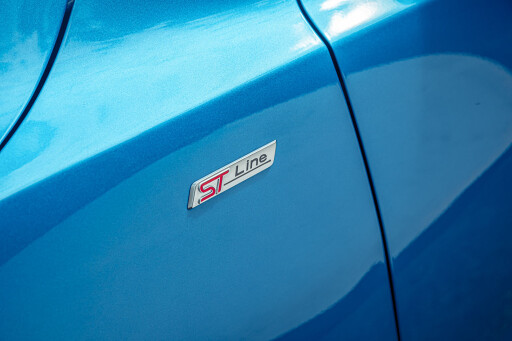 Special paints are another $650. A panoramic sunroof costs $2000, and a driver assistance pack that adds blind-spot warning, rear cross-traffic alert and active cruise control with stop-start functionality costs $1250.
Special paints are another $650. A panoramic sunroof costs $2000, and a driver assistance pack that adds blind-spot warning, rear cross-traffic alert and active cruise control with stop-start functionality costs $1250.
But the small jump to the Hyundai i30 N-Line, which costs $31,420, is justified by active cruise control, leather seats and larger 18-inch wheels.
Hyundai offers a few options. Our car scores a seven-speed dual-clutch automatic transmission for $2000. There is also a Sports 18 pack available that finishes door sills and wheels in gloss black for $1720, while an interior pack adds a cargo liner and floor mats for $380.
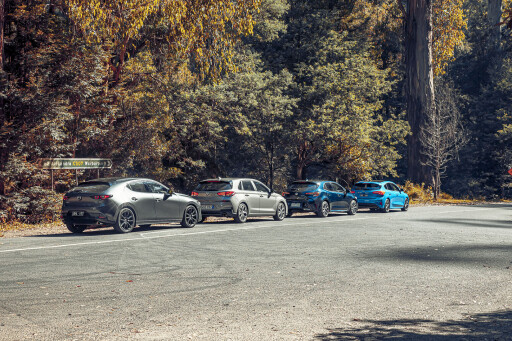 Step up to the Corolla ZR, however, and the standard equipment grows. Front parking sensors, a rear cross-traffic alert system and blind-spot warning are included, along with a head-up display. All this is yours for $32,695 (before on-roads).
Step up to the Corolla ZR, however, and the standard equipment grows. Front parking sensors, a rear cross-traffic alert system and blind-spot warning are included, along with a head-up display. All this is yours for $32,695 (before on-roads).
For a car Toyota hoped would appeal more to drivers, it seems strange the ZR exclusively packs a Continuously Variable Transmission. Those who want a manual transmission will need to settle on the entry-level Ascent Sport and miss out on the ZR-specific larger 18-inch wheels.
As for customisation, a full-fruit spec list on the ZR means the only option is a black roof that is available with a range of metallic colours. It costs $467 over and above the $526 charged for special paint.
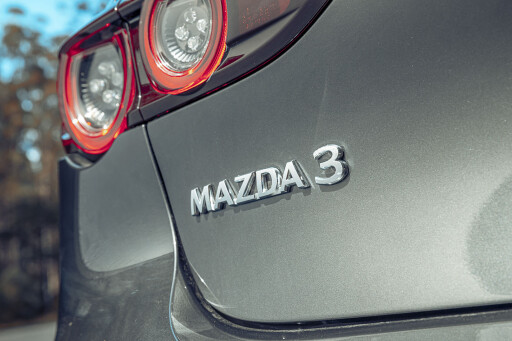 Want to spend big? Step up to the Mazda 3 X20 Astina with a Skyactiv-X engine. It costs $41,295.
Want to spend big? Step up to the Mazda 3 X20 Astina with a Skyactiv-X engine. It costs $41,295.
Mazda equips it like a Mazda 3 G25 Astina by ticking every box on the spec brochure – including front cross-traffic alert – while the Skyactiv-X mild-hybrid powertrain accounts for $3000 of its total price.
The only options available are metallic paint ($495 before on-roads) and a different 18-inch wheel design ($1660). The burgundy leather on our tester is a no-cost option. But you can personalise your 3 with an incredibly cool looking Kuroi Sports body kit as a factory accessory that includes new wheels for $4822.
The Mazda is surprisingly austere inside. It is also hard to discern just what features it has or how to use them because the cabin is so distractingly beautiful.
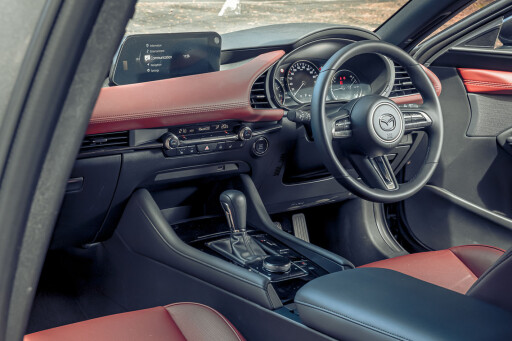 Take the vents around the steering wheel. See how they integrate with the instrument cluster housing? Clever. The centre console jambs match up with the armrest, and pushing the centre screen back into the dash allows more burgundy leather to sit front and centre.
Take the vents around the steering wheel. See how they integrate with the instrument cluster housing? Clever. The centre console jambs match up with the armrest, and pushing the centre screen back into the dash allows more burgundy leather to sit front and centre.
The front seats are also comfortable, well-positioned and nicely appointed. Kneeroom up back is spacious, thanks to its long wheelbase. But the pinched glasshouse eats into rear headroom and creates a sense of claustrophobia.
 The Ford offers a point of difference with its boxier shape. Inside is an airy cabin more spacious for ferrying people around. But you can feel where costs were saved by tapping the door cards or pushing down on the thinly-padded cloth seats.
The Ford offers a point of difference with its boxier shape. Inside is an airy cabin more spacious for ferrying people around. But you can feel where costs were saved by tapping the door cards or pushing down on the thinly-padded cloth seats.
The front workstation is functional, inoffensive and reserved. Ford has shown more restraint with buttons on the centre stack, and the steering wheel, too, which is lovely in hand with a soft and firm tactility. The rotary transmission control dial frees up space, but it also presents a functional nightmare when trying to rush between gear selections at low speed.
The Hyundai cabin is a small step up in quality. Straightforward design and good ergonomics set the scene, while N-Line red stitching and accents on the gear lever, leather-feel front seats and front vents spice things up. The leather-wrapped steering wheel is another treat.
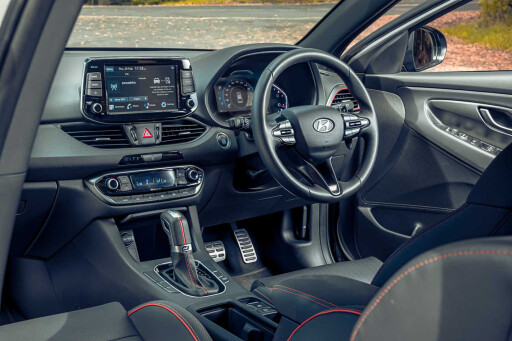 The Hyundai workstation cannot match the Mazda for luxury, but the inside feels built to a higher price than the Ford. The Hyundai trumps all on luggage space, with the spec sheet claiming the boot fits 395L.
The Hyundai workstation cannot match the Mazda for luxury, but the inside feels built to a higher price than the Ford. The Hyundai trumps all on luggage space, with the spec sheet claiming the boot fits 395L.
The Ford trails with 340L when the rear seats are up. After it, the Mazda manages 295L, while the Corolla lags on 217L. Toyota says a space-saver spare wheel and the fact the Corolla now has multi-link rear suspension are to blame, although Hyundai and Ford manage more cargo area while still having the spare wheels and multi-links.
Luckily the Corolla does better up front, where a cascading centre stack plays centrepiece to a sleek, sophisticated and more upmarket cabin. But the Corolla's angular body shape penalises rear headroom.
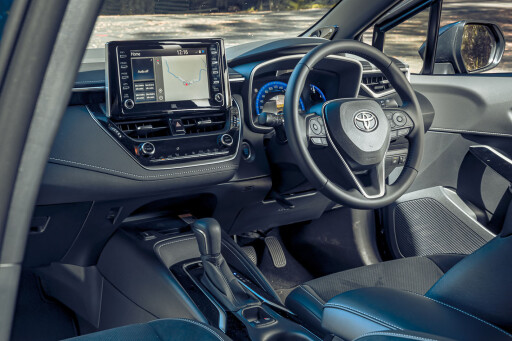 Yet, while this sporty pretence might seem overblown for something packing a CVT, the engine redeems some respect. The Toyota's engine measures 1987cc and squirts fuel directly into the cylinders while also using a super high 13.1:1 compression ratio.
Yet, while this sporty pretence might seem overblown for something packing a CVT, the engine redeems some respect. The Toyota's engine measures 1987cc and squirts fuel directly into the cylinders while also using a super high 13.1:1 compression ratio.
It happily gets around town on part throttle, sipping a claimed 8.5L/100km on an urban cycle. A conventional lock-up gear in the transmission gets it off the line well. Only when you squeeze the throttle harder can you sense some slack in the automatic.
Thankfully, the CVT tune imitates gears to get the most from the engine, scaling the complete rev range in manual mode when you need more control. Peak torque spreads from 4400-4800rpm. And while 200Nm of grunt is nothing special, the 125kW delivered at a heady 6600rpm gives it a top-end punch which is fun to wind up.
.jpg)
The Mazda 3 works with surprising ease considering the technology behind the Skyactiv-X powertrain. At its core is a direct-injected 1998cc twin-cam four-cylinder engine. And a supercharger that Mazda calls a high-response air supply unit stuffs the cylinders with the air needed to reach the stratospheric air-fuel ratios to support compression ignition. That is when the air and fuel mixture becomes so dense it self-ignites.
Calling the Skyactiv-X a compression ignition engine is slightly misleading since it still uses a spark plug to kick off combustion. It squeezes 134kW and 224Nm from just two litres and sips a claimed 6.5L/100km on an urban driving cycle – 2.0L/100km less than the Corolla. But on our road loop, defined by a highway run and a lot of fast driving, the Mazda's consumption figure was actually 10.13L/100km versus the Corolla’s 10.53L/100km.
The engine hungers for revs, like a small petrol engine, and pulls with the grunt of a diesel. But the supercharger and mild hybrid system add too much heft, so it feels slower than it should. And despite the fun of plucking the steering wheel’s paddles to change gears through the Mazda’s excellent six-speed automatic, it’s missing an X-factor.
 Cue the Hyundai. Its turbocharged 1.6-litre engine produces 150kW and 265Nm and blows all others away for response, power and speed. The N-Line’s seven-speed dual-clutch transmission is also in another league, changing cogs with lightning reactions.
Cue the Hyundai. Its turbocharged 1.6-litre engine produces 150kW and 265Nm and blows all others away for response, power and speed. The N-Line’s seven-speed dual-clutch transmission is also in another league, changing cogs with lightning reactions.
The power delivery is relatively violent and arrives after a small amount of turbo lag and torque steer across the front axle. But it also generates a mighty thirst. On our loop, the N-Line drank 13.53L/100km. It is claimed to drink 9.4L/100km on an urban cycle.
Ford’s downsized three-cylinder engine might not feel as big on performance as the Hyundai, but it still is more eager and willing than the Mazda or Toyota, with the turbocharger offering a good kick in the mid-range.
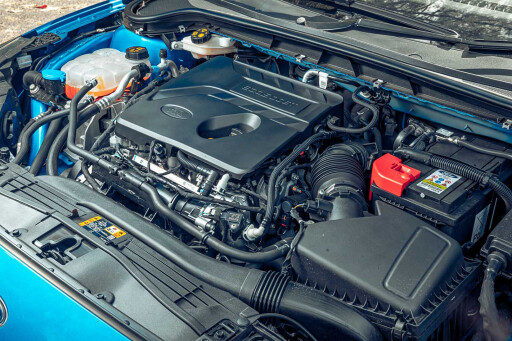 Paired with an eight-speed transmission that works well on the go, 134kW and 240Nm help the Focus accelerate hard over the whole rev range while playing an off-beat warble. It feels quicker than the Mazda and Toyota.
Paired with an eight-speed transmission that works well on the go, 134kW and 240Nm help the Focus accelerate hard over the whole rev range while playing an off-beat warble. It feels quicker than the Mazda and Toyota.
The Ford also separates the field on handling. Its lowered ride height pairs well with a multi-link rear suspension for light-footed confidence on the road, backed by creamy, accurate steering and good brakes.
But while the Ford’s taller 215/50 tyres afford it a comfortable secondary ride on its sportier suspension tune, the trade-off is that it can roll onto the sidewall during heavy cornering.
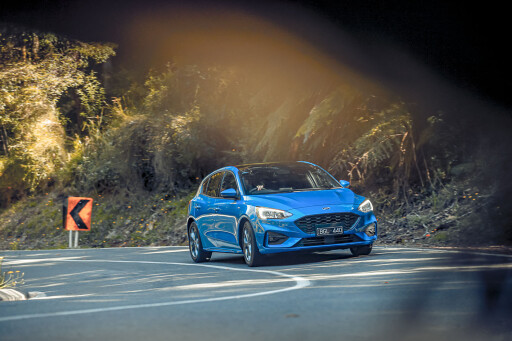 There’s no such problem in the Hyundai. Its Australian-tuned N-Line suspension on 18-inch wheels is decidedly firmer than the Focus, and the heavy steering hints at the levels of grip. It’s sharp, obedient and responsive, but also forgiving at its limit.
There’s no such problem in the Hyundai. Its Australian-tuned N-Line suspension on 18-inch wheels is decidedly firmer than the Focus, and the heavy steering hints at the levels of grip. It’s sharp, obedient and responsive, but also forgiving at its limit.
The Hyundai has also not sacrificed ride quality altogether. There's enough suppleness to iron out lumpy roads, although limited vertical movement in the suspension never lets you forget the compromised setup.
Surprisingly, the Corolla also struggles to settle on the low-profile 18-inch tyres unique to the ZR variant. It’s damped firmly to handle bumps and corners, and the combination of these two characteristics penalise the ride on rough roads.
 The upside is the Corolla has an edge on the Ford for handling. Its light, accurate steering generates good turn-in, and the chassis finds a reasonable amount of grip on the hard Dunlop tyres. Although it’s not in the same league as the N-Line, there’s a warm hatch somewhere within waiting to be released.
The upside is the Corolla has an edge on the Ford for handling. Its light, accurate steering generates good turn-in, and the chassis finds a reasonable amount of grip on the hard Dunlop tyres. Although it’s not in the same league as the N-Line, there’s a warm hatch somewhere within waiting to be released.
Funnily enough, you could say the same thing about the Mazda. The fourth-generation model has been lauded as a keen handler, except that’s not the case for the Skyactiv-X, given it adds almost 70kg over the 2.5-litre naturally aspirated version. Other than sweet and nicely-weighted steering, the extra weight dulls turn-in and further burdens a brake system that already feels wooden thanks to a regenerative function for mild-hybrid duties.
 The Mazda is much nicer to wheel around town, however, where you’re safe from venturing beyond the limits of grip. The ride up back is surprisingly comfortable given it’s the only car here that uses a torsion-beam rear setup, matching the Hyundai and Ford for rear occupant comfort. The Toyota, however, feels over-damped back there.
The Mazda is much nicer to wheel around town, however, where you’re safe from venturing beyond the limits of grip. The ride up back is surprisingly comfortable given it’s the only car here that uses a torsion-beam rear setup, matching the Hyundai and Ford for rear occupant comfort. The Toyota, however, feels over-damped back there.
While on that, it's worth mentioning all these cars are very usable day-to-day, except for a few flaws. Turbo lag plagues the Hyundai off the line. Meanwhile, the Ford’s eight-speed transmission takes a while to engage when changing the direction of travel between reverse and drive.
The Toyota’s CVT works well to keep the engine on the boil but can’t match the Mazda’s powertrain for engine or throttle response. It's only the Mazda that escapes serious criticism here. It also goes one step extra on safety with front cross-traffic alert and a 360-degree view monitor, helping it navigate busy streets and blind spots.

It's also worth mentioning all of these cars come with a five-year unlimited kilometre warranty as well as capped price servicing, with the latter offered over the first three years of Corolla ownership, five years with the Mazda 3, and then the lifetime of both the Hyundai i30 and Ford Focus. The i30's service plan is also transferable to the next owners.
To step back and think about our four, that Skyactiv-X powertrain in the Mazda is remarkably refined and punches above its size. It will also prove more frugal during stop-start driving when its mild-hybrid system, used to power ancillaries and relieve an alternator, comes into play.
But the Skyactiv-X’s extra torque and power are not a free-kick. More weight means the 2.5-litre Astina could offer the same level of luxury, refinement and class, as well as better handling and acceleration for less. It's hard to think of why you'd stump up the cash for the Skyactiv-X.
 Speaking of which, the Ford Focus ST-Line at first presents an appealing case on value. If you can look past the low quality feeling cabin materials and cheap-feeling seats, it’s a spirited drive and rides well with a liveable interior.
Speaking of which, the Ford Focus ST-Line at first presents an appealing case on value. If you can look past the low quality feeling cabin materials and cheap-feeling seats, it’s a spirited drive and rides well with a liveable interior.
Adding the safety pack for active cruise control, however, prices it lineball with the Toyota Corolla driveaway. And while the Corolla might fall behind the Focus on boot space and rear occupant comfort, it claws back points on its safety package – including a heads-up display, auto-reverse braking support and active cruise control.
 The Hyundai, however, goes some way to offering the best of both worlds, like active cruise control as standard and class-leading rear boot space. On balance, the Hyundai might miss out on some safety gear, but its crushing performance is backed by a practical interior, comfortable front seats and an attractive price tag.
The Hyundai, however, goes some way to offering the best of both worlds, like active cruise control as standard and class-leading rear boot space. On balance, the Hyundai might miss out on some safety gear, but its crushing performance is backed by a practical interior, comfortable front seats and an attractive price tag.
Yes, it’s on the firm side, drinks a bit more fuel, and might have expensive tyres, and the Corolla is as attractive a package for its simplicity and striking design, but that’s not enough to dampen the N-Line's all-round winning package. As far as a warm hatch goes, the Hyundai i30 N-Line is piping hot.
Verdict
Hyundai i30 N-Line 7.5/10
Pros: Proper performance and handling; roomy and practical; decent value on balance
Cons: Firmer ride; turbo lag; dated exterior styling
Toyota Corolla ZR 7.5/10
Pros: Sharp looks; comprehensive safety features; revvy and economical engine
Cons: Lack of rear elbow room and boot space; wooden ride
Ford Focus ST-Line 7/10
Pros: Characterful and eager engine; cabin room; comfortable ride quality
Cons: Feels built to a price; missing active cruise control; gearbox tardiness at low speed
Mazda 3 Skyactiv-X 7/10
Pros: Seamless operation; refined cabin; high build quality; sophisticated design
Cons: Hefty price; inert handling; brake feel; questionable performance benefit
Specifications
| Ford Focus ST-Line | Hyundai i30 N-Line | Toyota Corolla ZR | Mazda 3 Skyactiv-X |
| Body: five-door, five seat hatch
| Body: five-door, five seat hatch
| Body: five-door, five seat hatch
| Body: five-door, five seat hatch
|

COMMENTS